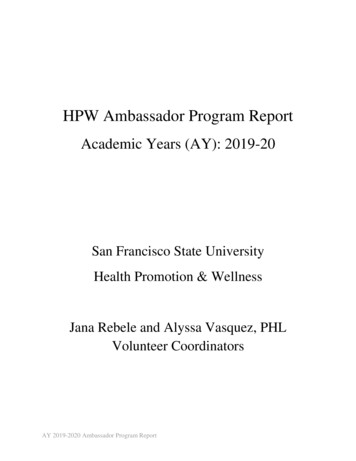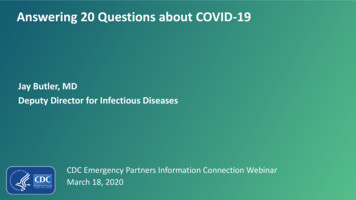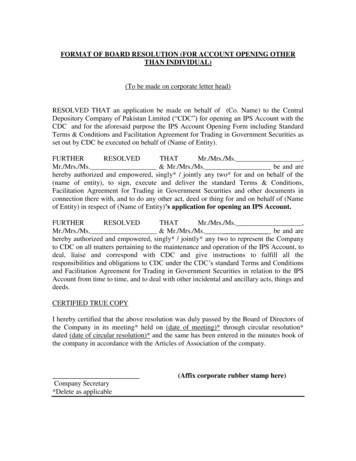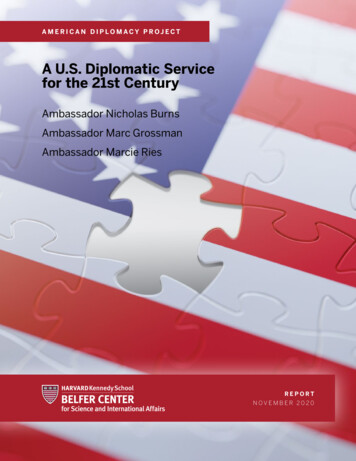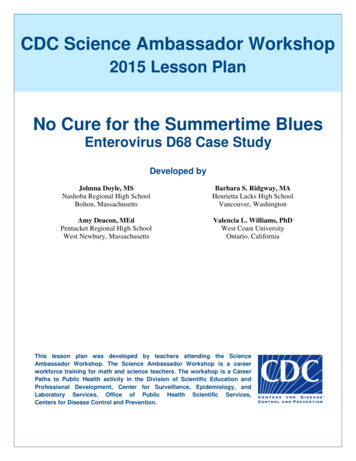
Transcription
CDC Science Ambassador Workshop2015 Lesson PlanNo Cure for the Summertime BluesEnterovirus D68 Case StudyDeveloped byJohnna Doyle, MSNashoba Regional High SchoolBolton, MassachusettsBarbara S. Ridgway, MAHenrietta Lacks High SchoolVancouver, WashingtonAmy Deacon, MEdPentucket Regional High SchoolWest Newbury, MassachusettsValencia L. Williams, PhDWest Coast UniversityOntario, CaliforniaThis lesson plan was developed by teachers attending the ScienceAmbassador Workshop. The Science Ambassador Workshop is a careerworkforce training for math and science teachers. The workshop is a CareerPaths to Public Health activity in the Division of Scientific Education andProfessional Development, Center for Surveillance, Epidemiology, andLaboratory Services, Office of Public Health Scientific Services,Centers for Disease Control and Prevention.
AcknowledgementsThis lesson plan was developed in consultation with subject matter experts from the Division ofScientific Education and Professional Development, Center for Surveillance, Epidemiology, andLaboratory Services, Office of Public Health Scientific Services, U.S. Centers for Disease Control andPrevention:Michael E. King, PhD, MSWCommander, United States Public Health Service EIS Field Officer Supervisor and EpidemiologistScientific and editorial review was provided by Ralph Cordell, PhD and Kelly Cordeira, MPH fromCareer Paths to Public Health, Division of Scientific Education and Professional Development, Centerfor Surveillance, Epidemiology, and Laboratory Services, Office of Public Health Scientific Services,Centers for Disease Control and Prevention.Suggested citationCenters for Disease Control and Prevention (CDC). Science Ambassador Workshop—No Cure for theSummertime Blues: Enterovirus D68 case study. Atlanta, GA: US Department of Health and HumanServices, CDC; 2015. Available at: .Contact InformationPlease send questions and comments to scienceambassador@cdc.gov.DisclaimersThis lesson plan is in the public domain and may be used without restriction.Citation as to source, however, is appreciated.Links to nonfederal organizations are provided solely as a service to our users. These links donot constitute an endorsement of these organizations nor their programs by the Centers forDisease Control and Prevention (CDC) or the federal government, and none should beinferred. CDC is not responsible for the content contained at these sites. URL addresses listedwere current as of the date of publication.Use of trade names and commercial sources is for identification only and does not implyendorsement by the Division of Scientific Education and Professional Development, Centerfor Surveillance, Epidemiology, and Laboratory Services, CDC, the Public Health Service, orthe U.S. Department of Health and Human Services.The findings and conclusions in this Science Ambassador Workshop lesson plan are those ofthe authors and do not necessarily represent the official position of the Centers for DiseaseControl and Prevention (CDC).
ContentsSummary . 1Learning Outcomes . 1Duration . 1Procedures . 2Day 1: Summertime Blues, Duration 45 minutes . 2Preparation . 2Materials . 2Online Resources . 2Activity . 3Day 2: Going Public without a Cure, Duration 45 minutes . 4Preparation . 4Materials . 4Activity . 4Conclusions . 5Assessments . 5Educational Standards . 7Appendices: Supplementary Documents . 9Worksheet 1A: Summertime Blues Case Study . 11Worksheet 1B: Summertime Blues Case Study, Guide . 21Worksheet 2: Public Service Announcement . 35
No Cure for the Summertime BluesEnterovirus D68 Case StudySummaryDuring late summer 2014, hospitals across the United States werereporting increases in the number of children with severerespiratory illness. These increases were initially reported fromMissouri and Illinois but other states were soon reporting similarincreases. Infection with enterovirus D68 (EV-D68) was found tobe the cause of many of these illnesses. Enteroviruses are membersof the picornavirus family, a group that includes the rhinoviruses(causes of the common cold). Other enteroviruses include thepolioviruses, coxsackieviruses and echoviruses, all of which arespread primarily through fecal-oral transmission. There is novaccine or anti-viral medicine that is effective against EV-D68.The following is a case study, based on a report in CDC’sMorbidity and Mortality Weekly Report (MMWR) titled “SevereRespiratory Illness Associated with Enterovirus D68 — Missouriand Illinois, 2014”, available 4.htm.Figure 1. This poster was created during a2014 increase in enterovirus D68 cases.Source: CDC PHIL ID #18056.In this case study, students will analyze data and information aboutthe outbreak as if it were happening in real time. They will use thisinformation to make decisions about how to effectively monitor and respond to an EV-D68 outbreak.Students will classify increases in numbers of persons with EV-D68 as a cluster, outbreak, epidemic, orpandemic to help justify planning decisions for conducting a field investigation. Students will apply acase definition to collect data needed to characterize an outbreak by using correct graphs and tables.Oral and written communication skills will be used to communicate findings to the public.This case study is intended for students in grades 9–12 and lower division biology or microbiologycollege classes. The case study can be included as a part of lessons concerning epidemiology and publichealth concepts. Students might need supplemental information to understand the concepts of viruses,disease transmission, and mathematics related to creation and interpretation of graphs.Learning OutcomesAfter completing this lesson, students should be able to: classify increases in occurrence of disease as clusters, outbreaks, epidemics, or pandemics; justify planning decisions for conducting a field investigation; apply a case definition to a field investigation; use empirical data presented in multiple formats (e.g., graphs or tables) to characterize an outbreak; develop a video public service announcement that communicates public health information to atarget audience.DurationThis lesson can be conducted as one, 90-minute lesson, or divided into two, 45-minute ones.1
ProceduresDay 1: Summertime Blues (45 minutes)PreparationBefore Day 1, Make copies of Worksheet 1A: Summertime Blues Case, one copy per student; Review Worksheet 1B: Summertime Blues Case, Answer Key; and Review online resources as needed.Materials Worksheet 1A: Summertime Blues CaseDescription: This case study uses a modified version of real outbreak. It encourages students to thinkcritically about viral transmission and using data and information to solve a public health problem. Worksheet 1B: Summertime Blues Case, GuideDescription: The guide provides background content and optional strategies to more fully engagestudents in the case study. It also has links to additional resources for information.Online Resources Severe Respiratory Illness Associated with Enterovirus D68 — Missouri and Illinois, 2014URL: htm.Description: This resource was used to develop the case study portion of this lesson plan. CDC’s Guidelines for Investigating Clusters of Health EventsURL: htm.Description: This resource was published by MMWR to provide guidelines for investigating clustersof health events. Review this resource before Part 1 of the case study. CDC’s Guidelines for Investigating Unexplained Respiratory Disease OutbreaksURL: http://www.cdc.gov/urdo/outbreak.html.Description: This resource was published by MMWR to provide guidelines for investigatingunexplained respiratory disease outbreaks. Review this resource before Part 2 of the case study. CDC Webinar: Enterovirus D68 in the United States: Epidemiology, Diagnosis & Treatment (2014)URL: http://emergency.cdc.gov/coca/calls/2014/callinfo 091614.asp.Description: This resource might be helpful to review immediately after the case study. The COCAcall provides greater context of the larger outbreak occurring in the United States.2
Activity1. Ask students about a disease outbreak recently in the news. Ask students why investigating thisoutbreak was important. Writing headings on the board as students come up with answers mighthelp. Headings can include the following: Magnitude (e.g., number of persons infected), Speed ofTransmission, Severity of Disease, and Preventable. Conclude the conversation by explaining tostudents a variety of reasons exists that health departments and CDC investigate outbreaks. Reasonscan include scientific, social, economic, environmental, cultural, and political.2. Distribute Worksheet 1A: Summertime Blues to each student. Introduce the case study and discuss thelearning objectives. Explain that students will investigate a modified version of a real outbreak scenariothat occurred during 2014. After the introduction, consider having students read CDC’s Guidelines forInvestigating Unexplained Respiratory Disease Outbreaks. See online resources.3. Guide students through the case study. Follow notes in the guide for background information andteaching strategies for each question.4. For homework, have students watch the CDC webinar Enterovirus D68 in the United States:Epidemiology, Diagnosis & Treatment (2014). See online resources.3
Day 2: Going Public without a Cure, 45 minutesPreparationBefore Day 2, Make copies of Worksheet 2: Public Service Announcement, one copy per student.Materials Worksheet 2: Public Service Announcement, one copy per studentDescription: Students will use this worksheet as a guide to developing a public serviceannouncement (PSA) concerning EV-D68. Computers and Internet accessOnline Resources CDC VideosLink: http://www.cdc.gov/parents/cdc tv videos.html.Description: This website provides samples of video PSAs concerning different topics. Social Media at CDCLink: html.Description: This website provides examples of infographics used at CDC, and links to CDC-TVand the CDC Streaming Health channel on YouTube.Activity1. Ask students about the CDC webinar. Discuss how the case study completed on day 1 was only alimited representation of what was happening on a larger scale. Discuss with students that theinformation gained from the case study provides important information, but that in consideration ofthe larger outbreak, might need modification.2. Explain to students that they will work in groups of four to develop a 60-second PSA that focuses onthe spread of EV-D68 and a solution to the problem. Ask students to define their target audiencebefore starting their PSA. Encourage students to use social math and to review CDC videos andsocial media to help them frame a message and design the PSA.4
ConclusionsIn this lesson plan, a case study will be used to teach concepts of viral disease transmission, whileimproving student skills in classification, critical thinking, and by using data to justify decision making.Students will learn epidemiology and a public health science vocabulary, and how to apply them to amodified version of an outbreak scenario. Students will practice by using questions to define problems,carry out investigations, and analyze and interpret data in different forms to develop a hypothesis,construct an explanation, and communicate information.Assessments Worksheet 1A: Summertime Blues CaseLearning Outcome(s) met:- classify an increase in the occurrence of a disease as a cluster, outbreak, epidemic, or pandemic;- justify planning decisions for conducting a field investigation;- apply a case definition to a field investigation; and- use empirical data presented in multiple formats (e.g., graphs or tables) to characterize anoutbreak.Description: This case study uses a modified version of real outbreak scenario that encouragesstudents to think critically about viral transmission and by using data and information to solve apublic health problem. Worksheet 2: Public Service Announcement, one copy per studentLearning Outcome met:- develop a video public service announcement that communicates public health information to atarget audience.Description: Students create a unique video public service announcement that focuses on enterovirusD68 and disease control strategies. They create an audience-appropriate PSA concept and use socialmath to frame the message. Then, they write, plan, record, and edit a 60-second PSA.5
6
Educational StandardsIn this lesson, the following CDC Epidemiology and Public Health Science (EPHS) Core Competenciesfor High School Students1, Next Generation Science Standards * (NGSS) Science & EngineeringPractices2, and NGSS Cross-cutting Concepts3 are addressed:HS-EPHS1-2. Discuss how epidemiologic thinking and a public health approach is used to transform anarrative into an evidence based explanation.NGSS Key Science & Engineering Practice2Obtaining, Evaluating and Designing SolutionsCommunicate scientific and/or technical information or ideas (e.g. about phenomena and/orthe process of development and the design and performance of a proposed process or system)in multiple formats (i.e., orally, graphically, textually, mathematically.)NGSS Key Crosscutting Concept3Cause and EffectEmpirical evidence is required to differentiate between cause and correlation and makeclaims about specific causes and effects.HS-EPHS2-3. Use models (e.g., mathematical models, figures) based on empirical evidence to identifypatterns of health and disease in order to characterize a public health problem.NGSS Key Science & Engineering Practice2Analyzing and Interpreting DataAnalyze data using tools, technologies, and/or models (e.g., computational, mathematical) inorder to make valid and reliable scientific claims or determine an optimal design solution.NGSS Key Crosscutting Concept3Cause and EffectEmpirical evidence is needed to identify patterns.HS-EPHS4-2. Use a targeted health promotion and communication approach (taking into considerationscientific, the organization of systems and their patterns of performance, prioritized criteria, and tradeoff considerations) to design intervention strategies.NGSS Key Science & Engineering Practice2Constructing Explanations and Designing SolutionsDesign, evaluate, and/or refine a solution to a complex real-world problem, based onscientific knowledge, student-generated sources of evidence, prioritized criteria, and trade-offconsiderationsNGSS Key Crosscutting Concept3Structure and FunctionInvestigating or designing new systems or structures requires a detailed examination of theproperties of different materials, the structures of different components, and connections ofcomponents to reveal its function*Next Generation Science Standards is a registered trademark of Achieve. Neither Achieve nor the lead states and partnersthat developed the Next Generation Science Standards was involved in the production of, and does not endorse, this product.7
123Centers for Disease Control and Prevention (CDC). Science Ambassador Workshop—Epidemiology and Public HealthScience: Core Competencies for high school students. Atlanta, GA: US Department of Health and Human Services, CDC;2015.NGSS Lead States. Next Generation Science Standards: For States, By States (Appendix F–Science and EngineeringPractices). Achieve, Inc. on behalf of the twenty-six states and partners that collaborated on the NGSS. 2013. Available NGSS Lead States. Next Generation Science Standards: For States, By States (Appendix G–Crosscutting Concepts).Achieve, Inc. on behalf of the twenty-six states and partners that collaborated on the NGSS. 2013. Available 20edited%204.10.13.pdf.8
Appendices: Supplementary Documents9
10
Worksheet 1ANo Cure for the Summertime BluesEnterovirus D68 Case Study Answer KeyDirections: Read the case study scenario. Answer the questions.Case OverviewDuring late summer 2014, hospitals across the United Stateswere reporting increases in the number of children with severerespiratory illness. These increases were initially reported fromMissouri and Illinois but other states were soon reporting similarincreases. Infection with enterovirus D68 (EV-D68) was foundto be the cause of many of these illnesses. Enteroviruses aremembers of the picornavirus family, a group that includes therhinoviruses (causes of the common cold). Other enterovirusesinclude the polioviruses, coxsackieviruses and echoviruses, all ofwhich are spread primarily through fecal-oral transmission.There is no vaccine or anti-viral medicine that is effectiveagainst EV-D68.The following is a case study, based on a report in CDC’sMorbidity and Mortality Weekly Report (MMWR) titled “SevereRespiratory Illness Associated with Enterovirus D68 — Missouriand Illinois, 2014”, available 4.htm.At the end of this case study, students will be able to classify increases occurrence of disease as clusters,outbreaks, epidemics, or pandemics; justify planning decisions for conducting a field investigation; apply a case definition to a field investigation; and characterize an outbreak by using correct graphs and tables.Figure 2. This poster was created during a2014 increase in enterovirus D68 cases.Source: CDC PHIL ID #18056.Note: This case is based on investigations conducted by Claire Midgley, PhD, MS, EpidemicIntelligence Service officer, Division of Viral Diseases, National Center for Immunization andRespiratory Diseases, Centers for Disease Control and Prevention, and Mary Anne Jackson, MD,Infectious Disease Department, Children's Mercy Hospital, Kansas City, Missouri, with substantialcontributions from the Department of Pathology and Laboratory Medicine, Children's Mercy Hospital,Kansas City, Missouri; Missouri Department of Health and Senior Services; University of ChicagoMedicine; and the Illinois Department of Public Health. Their report can be found a4.htm. Details of the investigations have beenmodified for the educational purposes of this case study.11
Part 1: Emergence of a mysterious respiratory illness in ChicagoOn August 20, 2014, a boy aged seven years was brought to University of Chicago Medicine ComerChildren's Hospital in Illinois. He had symptoms of a mild respiratory illness, including runny nose,sneezing, cough, and body and muscle aches. After examination, the physician sent him home. Heinstructed the mother to get him to drink plenty of fluids and prescribed cold medicine to make the boycomfortable.Two days later, the boy’s condition had deteriorated. He had shortness of breath, coughing, andwheezing. His mother brought him back to the hospital. The physician’s diagnosis was acute respiratorydistress. The boy’s physician consulted with the emergency department physician, and the boy wasadmitted to the pediatric intensive care unit (PICU).Later that night, three additional children, aged six to nine years, were admitted to PICU. They wereadmitted through the emergency department with similar symptoms. Two had a history of asthma. Onegirl, who had especially severe symptoms, was put on a ventilator. Health care providers interviewedeach parent about their child’s symptoms. All parents reported that the symptoms seemed to getprogressively worse during a three-day to four-day period. The symptoms suggested a viral infection,perhaps due to the same virus. To confirm, health care providers collected stool and respiratoryspecimens for laboratory testing.While awaiting laboratory results, health care providers consulted with the Chief of the InfectiousDisease Department. Since this represented an unusual cluster of patients with this condition in themetro area, they also called the Chicago Board of Health to report the cases and to inquire if otherhospitals in the area were reporting similar cases.Question 1: How would you classify the four recent cases of the mysterious respiratory illness atChildren’s Hospital in Chicago? Choices include cluster, outbreak, epidemic, or pandemic? Explain.Question 2: At this point, is a need for further investigation necessary? Yes or no, and why or why not?Should Centers for Disease Control and Prevention (CDC) be called in to assist? Yes or no, and why orwhy not?12
Part 2: Confirming an outbreak of enterovirus D68Local health authorities confirmed 13 similar cases were reported by three other Chicago area hospitalsduring the past week. Patients were male and female, ranging in age from six to 10 years. Two malepatients, both aged seven years, died within a week of being admitted to PICU.The Illinois Department of Public Health requested CDC assistance. Local diagnostic laboratory testingusing polymerase chain reaction assay on a multiplex platform was able to determine if enteroviruses orrhinoviruses were present but not tell which (i.e., specimens were reported positive forenterovirus/rhinovirus). Viral genome sequencing at CDC was able to give more specific results. TheCDC found samples from all four patients from University of Chicago Medicine Center Children'sHospital and 10 of 13 patients from the other area hospitals to be positive for EV-D68.CDC epidemiologists arrived the next day and teamed up with local health department epidemiologistsand physicians from affected Chicago hospitals to investigate the outbreak. An epidemiologist andphysician interviewed the parent of each patient.Question 3: What types of information should be collected during this investigation?13
Part 3: First patients from MissouriCDC was initially notified of 10 patients in Missouri with illness similar to that reported in Illinois.Three female children ranged in age from six to seven years and seven male children ranged in age fromseven to 11 years. Seven patients had difficulty breathing, shortness of breath, cough, wheezing andfever, three required a respiratory breathing machine. Specimen testing confirmed EV-D68 in allpatients.Five patients in Colorado were reported. All were males ranging in age from eight to 10 years andpresented with similar symptoms. Clinical specimens were sent to CDC for testing.The state health departments in Missouri and Colorado requested CDC assistance. Teams of CDCepidemiologists were sent to each state to work with the health department and local hospitals.This emergence of multiple outbreaks and investigations in different states led to the development of astandard case definition. A case definition is a set of standard criteria for classifying whether a personhas a particular disease, syndrome, or other health condition. It typically consists of clinical criteria andoften includes limitations on time, place, and person. The clinical criteria usually include confirmatorylaboratory tests, if available, or combinations of symptoms (subjective complaints), signs (objectivephysical findings), and other findings.CDC epidemiologists developed the following case definition for this outbreak under age 21 years; admitted to hospital with severe respiratory illness; reported symptoms began on or after August 1, 2014; and confirmed positive for EV-D68 in respiratory specimens.Question 4: Why was it necessary to establish a case definition?14
The teams in each state compiled data concerning age, sex, state where hospitalization occurred,symptom onset date, and clinical confirmation into a line list (Table 1). Teams shared all data with eachother and uploaded data onto the National Enterovirus Surveillance System (NESS). Although isolatedenterovirus infections are not reportable nationally1, CDC sent out a directive nationwide requesting thatall laboratory detections of enterovirus be reported to NESS.Question 5: Indicate a reason why isolated enterovirus infections are not reportable.Question 6: Why did CDC send out a directive nationwide requesting that all laboratory detections ofenterovirus be reported to NESS? Should this system remain after the outbreak subsides?Question 7: On the basis of the case definition, describe how you would identify which reports inTables 1A–1D meet the case definition. Then, complete the last column of the table (titled Case?) usinga Yes or No answer.1Polioviruses are enteroviruses and polio is nationally reportable. The majority of states also require reporting of outbreaksor unusual increases in illnesses due to unknown or otherwise nonreportable causes. Only a fraction of cases get reported –even when the condition is reportable. Factors such a severity of illness, available time, interest, and especially resourcesinfluence reporting. Severe illnesses are more likely to be reported than milder ones. Facilities with more resources tend tobe better reporting sources than those with less.15
Table 1A: Reported cases of enterovirus D68 with severe respiratory distress, by onset week — ChicagoChildren Hospital, IllinoisStateClinicalCase # Date of BirthSexHospitalizedOnset /2014YesTable 1B: Reported cases of enterovirus D68 with severe respiratory distress, by onset week — ColoradoStateClinicalCase # Date of BirthSexHospitalizedOnset ado8/27/2014Yes16
Table 1C: Reported cases of enterovirus D68 with severe respiratory distress, by onset week — Illinois,other than Chicago hospitalsStateClinicalCase # Date of BirthSexHospitalizedOnset s8/24/2014Yes5410/3/2004F
The Science Ambassador Workshop is a career workforce training for math and science teachers. The workshop is a Career Paths to Public Health activity in the Division of Scientific Education and Professional Development, Center for Surveillance, Epidemiology, and Laboratory Services, Office of Public Health Scientific Services,



